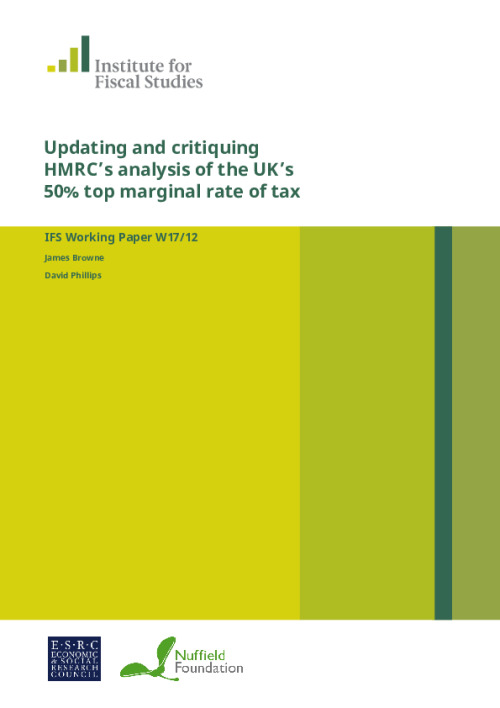In April 2010 the UK's marginal rate of income tax above £150,000 was increased from 40% to 50%, affecting the highest-income 0.66% of the adult population (and 1% of income taxpayers). This would seem an ideal opportunity to obtain an estimate of the taxable income elasticity, but identification is impeded by forestalling (individuals bringing forward income to the year before the tax rate was increased) resulting from the reform being announced more than a year in advance.
This forestalling hampered an attempt by HMRC (the UK’s tax authority) to estimate the revenue effects of the tax rise (HMRC, 2012) using incomplete data from the first year of the higher tax rate (2010–11). This analysis used an aggregate difference-in-difference approach. In this paper we update this analysis, using more complete data on the first year following the reform (2010–11) and an additional year of data (2011–12) that was unavailable when HMRC conducted their analysis. Using a similar method to HMRC (2012), we estimate an elasticity of around 0.31 based on the response in 2010–11, and 0.83 based on the response in 2011–12.
We next refine HMRC (2012)’s methodology for estimating how much of the forestalled income came from 2010–11 and how much from subsequent years. We find that all else equal, HMRC's method for estimating from which years forestalled income came – which suggests that around 70% came from 2010–11 – is likely to lead to overestimates of how much came from these initial post-reform years, and hence underestimate the underlying taxable income elasticity. An alternative method that better accounts for these issues suggests around 45% was unwound in 2010–11, and around one-sixth unwound in 2011–12, implying an elasticity of 0.58 based on the response in 2010–11 and 0.95 based on the response in 2011–12. These would both imply negative revenues from the increase in the top tax rate to 50%.
Finally, we show the sensitivity of HMRC (2012)’s estimates to changes in the specification of the model used to estimate the counterfactual incomes of the group affected by the 50% tax rate. We find that relatively small changes to the specification yield very different results, with higher taxable income elasticity estimates frequently in excess of unity. The range of reasonable central estimates that the UK’s Office for Budget Responsibility could use to estimate the revenue effects of changes to the UK’s top income tax rate is therefore wide.
However, it is important to sound three notes of caution here. First, if individuals anticipated (correctly) the 50% rate being reduced in later years (or were able to respond to the announcement made towards the end of the 2011–12 tax year that it would be reduced to 45% in 2013–14), they may also have delayed receiving income. We still obtain higher taxable income elasticity estimates than HMRC (2012) when we assume that individuals were able to delay as much income from 2011–12 to 2013–14 as they were able to bring forward from 2011–12 to 2009–10, but it may be the case that delaying income is easier than bringing it forward. If this were the case, more of the overall response to the 50% tax rate may represent temporary timing effects as opposed to underlying response, which would imply that the estimates of the underlying taxable income elasticity may be overestimates. Second, some behavioural responses, such as additional occupational pension contributions, or retention of income in businesses, while reducing income tax revenues in the short-term, generate at least some revenue in the longer-term. Third, the estimate of the counterfactual is very imprecisely defined, meaning that the estimates from the different specifications are not statistically significantly different from each other, or indeed from zero. The central estimates of HMRC (2012) are therefore still very much within the margin of error of our estimates. There is therefore still significant uncertainty in both directions around HMRC’s estimates of the taxable income elasticity of high earners, and hence the revenue effects of the 50% rate.











